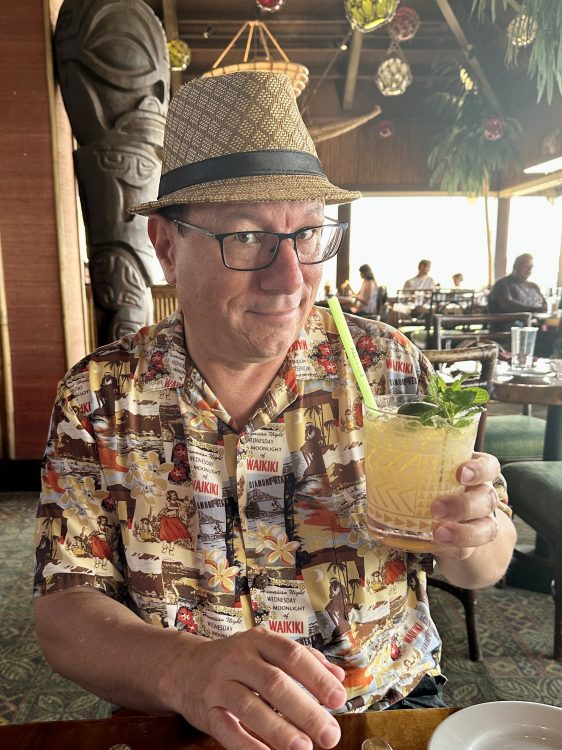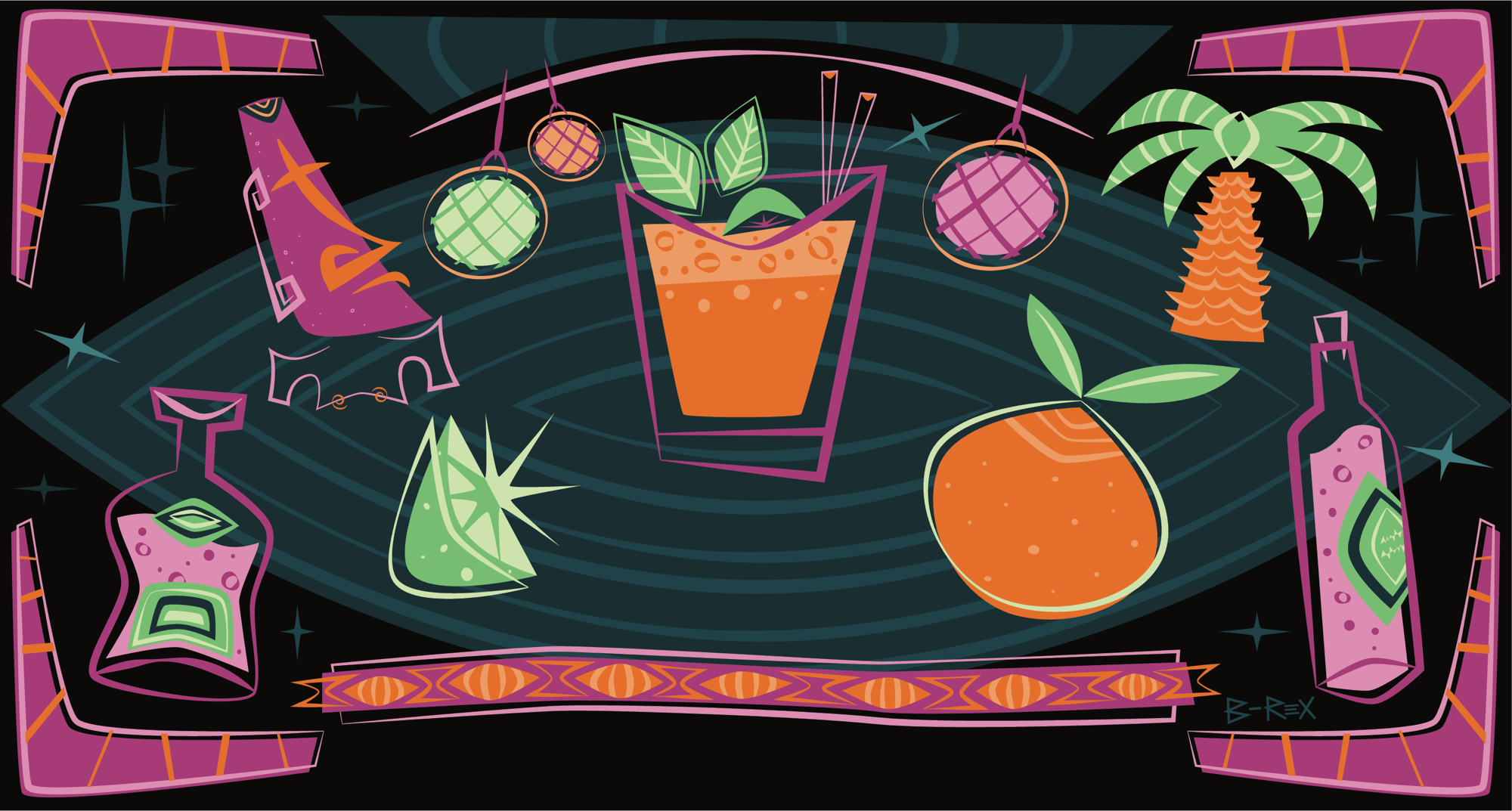By Kevin Crossman
Every hero needs a great origin story. And our hero, the mighty Mai Tai, certainly has an origin story that seems to be drawn from fantastic literature. And considering that the father of the story was infamous for telling tall tales it’s even harder to fathom.
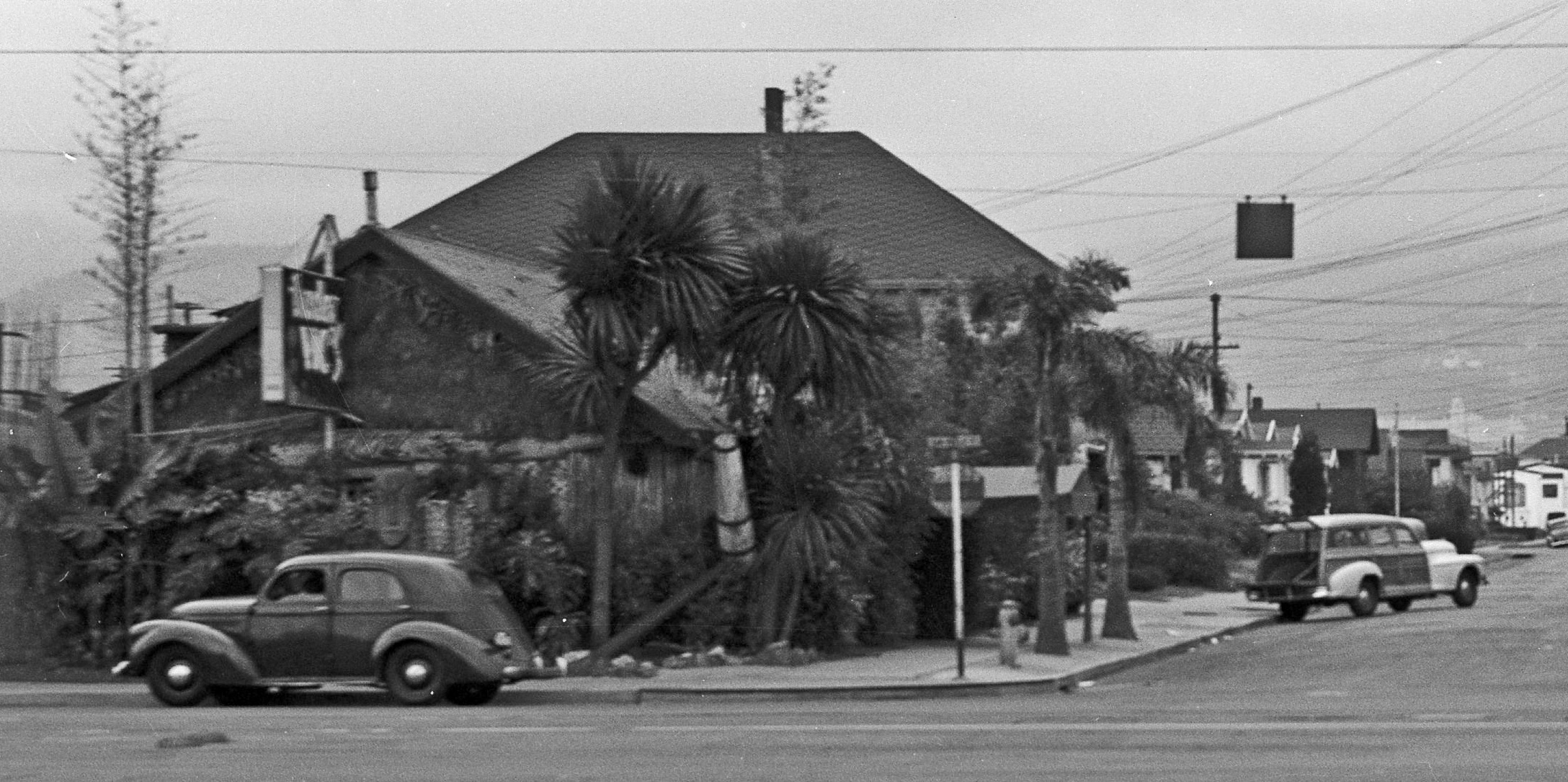
As the story goes… the year was 1944. Victor Bergeron had been operating a bar at 65th and San Pablo Ave. in Oakland for about ten years, the last several under the moniker “Trader Vic’s.” Since renaming the bar and adopting a Polynesian theme, business improved. But The Trader was always tinkering at his service bar.
In 1944, after success with several exotic rum drinks, I felt a new drink was needed. I thought about all the really successful drinks; martinis, manhattans, daiquiris …. All basically simple drinks.
I was at the service bar in my Oakland restaurant. I took down a bottle of 17-year old rum. It was J. Wray Nephew from Jamaica; surprisingly golden in color, medium bodied, but with the rich pungent flavor particular to the Jamaican blends.
The flavor of this great rum wasn’t meant to be overpowered with heavy additions of fruit juices and flavorings. I took a fresh lime, added some orange curacao from Holland, a dash of Rock Candy Syrup, and a dollop of French Orgeat, for its subtle almond flavor. A generous amount of shaved ice and vigorous shaking by hand produced the marriage I was after.
I stuck in a branch of fresh mint and gave two of them to Ham and Carrie Guild, friends from Tahiti, who were there that night.
Carrie took one sip and said, “Mai Tai – Roa Ae”. In Tahitian this means “Out of This World – The Best.” Well, that was that. I named the drink “Mai Tai.”
Source: Setting the Record Straight, 1970
All those little details are there. The fine ingredients from far-away countries. The friends who just happened to be in town visiting from a Polynesian island. The name that expressed itself as “the best.” Well, either Trader Vic found himself in a dream scenario, or perhaps the Trader was… embellishing. After all, this was the same guy who’d stab forks in his wooden leg saying that he lost it to a shark – when in reality he lost the leg to a childhood disease.
The Original Formula by Trader Vic Bergeron, 1944
2 ounces of 17-year old J. Wray & Nephew Rum over shaved ice
½ ounce Holland DeKuyper Orange Curacao
½ ounce French Garnier Orgeat Syrup
¼ ounce Trader Vic’s Rock Candy Syrup
Add juice from one fresh Lime.
But for now let’s take the story on face value that as Vic often did he was developing a new cocktail. The French almond syrup Orgeat was already part of the Fog Cutter and Scorpion cocktails and it was paired with a rich, long aged rum for some special guests. That’s decidedly less far-fetched. Trader Vic had a great palette and his riff on a Rum Sour was a delight, and inclusion of the almond-based Orgeat and orange-based Curacao provided additional depth to the cocktail. With only five ingredients the Mai Tai is fairly simple in execution and allows a quality rum to shine. That name sure sounded perfect for his Polynesian restaurant and with the endorsement of his friends, Vic must have realized he stumbled onto a winner.
According to Trader Vic’s lore, the new cocktail became an immediate hit and caused supplies of the famed 17-year old rum to evaporate. There’s all kinds of evidence that Wray & Nephew 17 was an oddball limited release, though Wray had plenty of 15 yr rum for Trader Vic to use when the 17 ran out after a year. But was the Mai Tai actually a hit? The supposed history on this is quite fuzzy.
For one, if this was such an immediate hit why is there no mention of the Mai Tai in Bergeron’s 1946 Book of Food and Drink? Or in the Bartender’s Guide published the next year?
Curious.
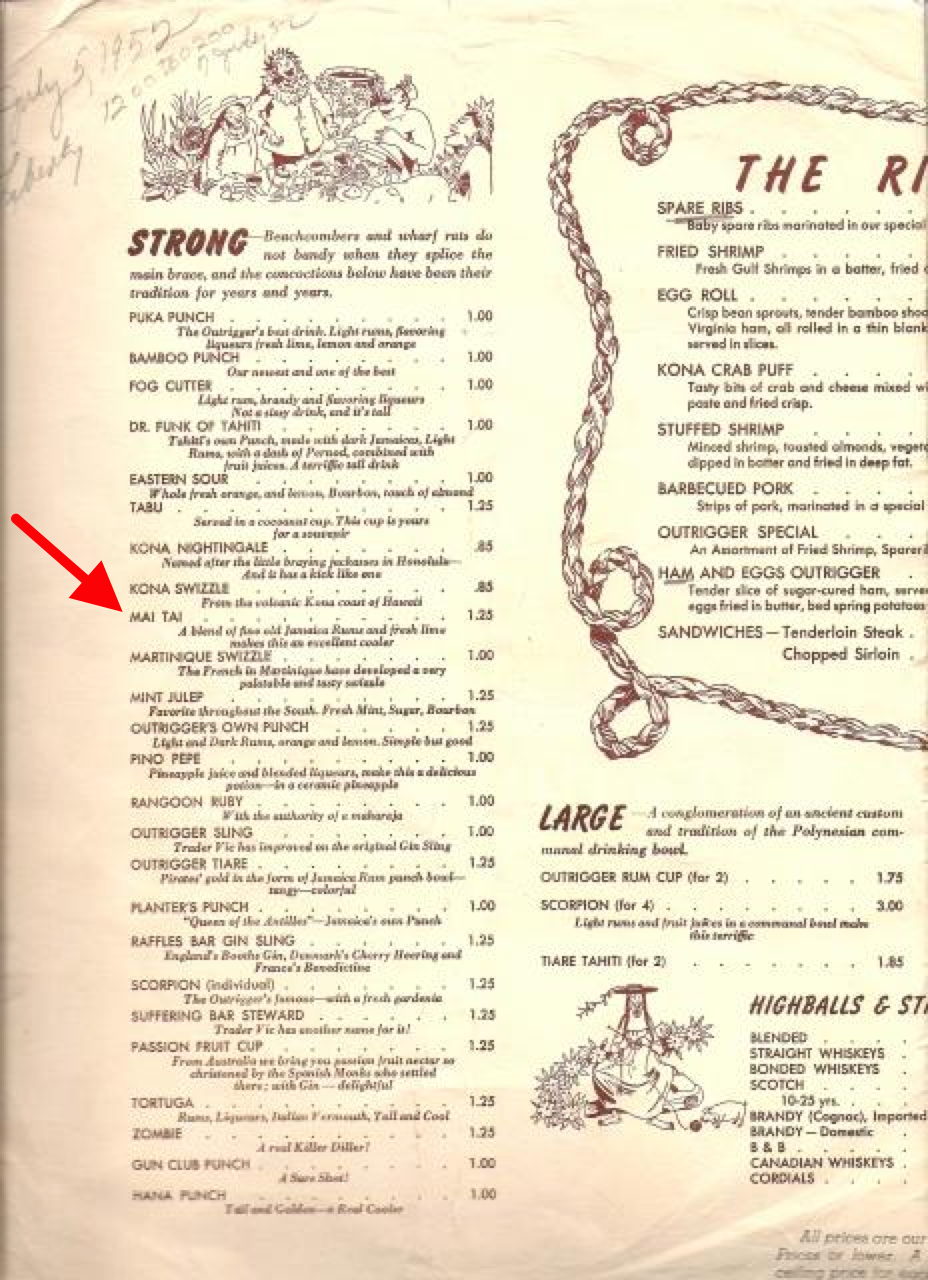 If the Mai Tai was such an instant hit, why was it buried in the middle of the cocktail menu of The Outrigger, a Trader Vic’s spinoff in Seattle, rather than being a featured cocktail like the Fog Cutter?
If the Mai Tai was such an instant hit, why was it buried in the middle of the cocktail menu of The Outrigger, a Trader Vic’s spinoff in Seattle, rather than being a featured cocktail like the Fog Cutter?
Why aren’t there any newspaper accounts of a new breakout hit cocktail in Oakland in the 1940s?
Because the Mai Tai wasn’t a breakout hit.
But by the dawn of the 1960s, the Mai Tai was the most famous tropical cocktail in the world and was being asked for in bars across America. What changed?
The Mai Tai Goes Viral in Hawai’i
In 1953, Bergeron was contracted with the Matson Navigation Co. to produce a food and cocktail menu for their Royal Hawaiian and Moana hotels on Waikiki Beach in the Territory of Hawai’i. Those menu items seemed to make an impression on the tourists and there were plenty of them to speak about their culinary experiences! Hawaiian tourism was really gearing up in the early 1950s and was a veritable phenomenon by the end of the decade when Hawai’i became the 50th state.
The Royal Hawaiian’s menu had ten cocktails including the Mai Tai, an exotic sounding drink that as a key selling point was said to be “from Tahiti.” That sure sounded a lot better than if it was referencing the true origin in Oakland. Trader Vic loved the cocktail so much that he specifically called out the Mai Tai when promoting the menu in early 1953, even though it wasn’t even the featured cocktail. The Royal Planters Punch topped that list of drinks, made with pineapple juice and bold rums. But nobody remembers the Royal Planters Punch because it was the Mai Tai that soon became a sensation on the island. National recognition came soon thereafter, including a 1959 syndicated column that declared that the Mai Tai was the “top tourist tantalizer” supplanting the Zombie. Notable mentions in popular media such as Elvis’ Blue Hawaii cemented the cocktail in the public’s consciousness.
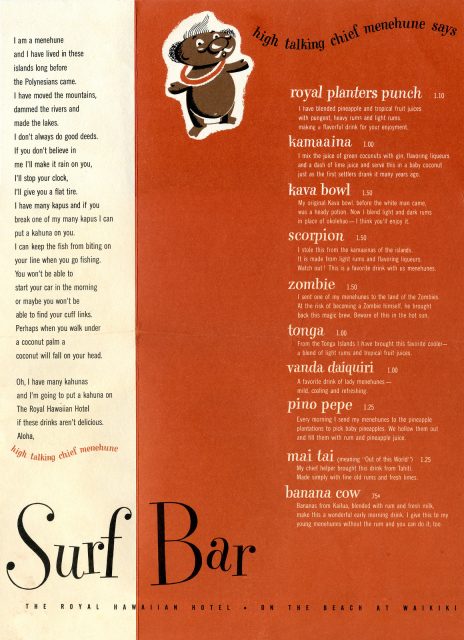
So, what was the original Hawaiian Mai Tai? Published recipes varied slightly, but they all featured the same building blocks and Bergeron himself provided the recipe in this style to a customer in 1956. Rather than expensive long-aged Jamaican rums, the 1950s style Hawaiian Mai Tai used a readily available dark Jamaican rum as a base, with the popular Myers’s being the standard bearer. This Myers’s was 100% pot-still based and issued at 97 proof, making it a little boozy and significantly more flavorful than the expression you find today. A light Puerto Rican rum was used to lengthen the drink and make it more approachable for tourists. Besides the use of both light and dark rum, the sweeteners were always included in equal parts.
This was the Mai Tai that became world-famous.
The Original Hawaiian Mai Tai by Trader Vic Bergeron, 1950s
Juice of one Lime (1 oz)
⅓ oz Orgeat
⅓ oz Rock Candy Syrup
⅓ oz Orange Curacao
1½ oz Light Puerto Rican Rum
1½ oz Dark Jamaican Rum
Many people assume that this original Hawaiian Mai Tai was the version we see today, made with pineapple juice and orange juice and a gigantic dark rum float. But the 1950s Mai Tai was more like the original and continued to be popular throughout the 1960s and beyond; the Halekulani Hotel in Waikiki still serves a Mai Tai in this style. Many Mai Tai recipes published in the 1950s-1960s in books and nationwide newspaper articles used a recipe with these ingredients. In fact, pineapple juice wasn’t part of any published Mai Tai recipe until the 1960s and long after the Mai Tai became synonymous with the islands.
With the Mai Tai’s word of mouth spreading to the mainland, soon every bar in Hawai’i was serving a Mai Tai to cater to tourists. The recipe was no secret and the building blocks of Orgeat and Orange Curacao were typically used in this period, but over time variations of the Hawaiian Mai Tai began to appear. By the 1960s, pineapple juice and the iconic dark rum float began to be used more widely, though the Royal Hawaiian and Moana hotels stuck with the original recipe until the early 1970s. As cocktails of all sorts started to use premixed ingredients in the 1970s-1980s, the Mai Tai was no exception. Variants that included Amaretto and Grenadine became common thereafter, but it is important to know that none of these variants were introduced by Trader Vic himself.
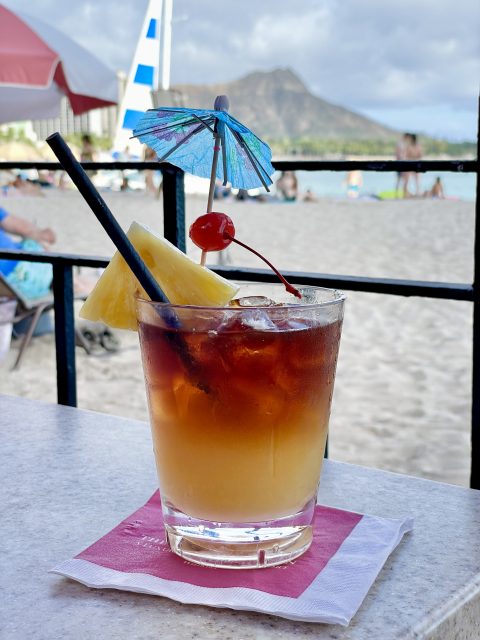
We Know Who Invented the Mai Tai
As Trader Vic’s entered the 1960s, the business was expanding. Not just the restaurants, which by this time numbered more than a dozen. But the food products. Trader Vic’s sauces. Trader Vic’s syrups. Trader Vic’s Rum. And, yes, Trader Vic’s Mai Tai mix. This is where things got a little heated.
You see, Donn Beach was also in the food products business, or at least willing to license the Don the Beachcomber name for food product labels. And having a Mai Tai mix under the Don the Beachcomber label made good business sense. After all, Don the Beachcomber also had a Mai Tai on the menu, the Mai Tai Swizzle. Years later we’d learn the recipe for this Mai Tai didn’t have much to do with Vic’s version or the later Hawaiian variants. But who created the Mai Tai first? The only evidence that the Mai Tai Swizzle predated Bergeron’s is via an undocumented story told by a less than impartial witness, Donn Beach’s widow Phoebe.
In any case, the issue came up when Vita-pakt Citrus Product Co. licensed the Don the Beachcomber name and then tried to copyright the Mai Tai mix. This drew the ire of Trader Vic’s who sued over the right to use the name. Donn and Vic buried the hatchet in 1970 when the lawsuit was settled out of court in favor of Trader Vic’s and therefore winning bragging rights to the Mai Tai. Carrie Guild filed an affidavit attesting to the authenticity of Vic’s origin story and Bergeron published the recipe in a 1970 press release. And that pretty much was that, apart from the myriad old wife’s tales that continue to this day (“nobody knows who invented the Mai Tai.”) This was settled history more than fifty years ago, folks.
Resurrecting the Mai Tai
While all of this is well and good, even Trader Vic’s published recipe didn’t mean that you were likely to get a good tasting Mai Tai at most places until recently, and even then it has to be at a quality bar or restaurant. At many places a “Mai Tai” is simply synonymous with “rum, tons of fruit juice, probably dark or red, topped with a cherry.” Easy to drink, but not really a true Mai Tai.
The person most responsible for raising awareness of the Mai Tai’s original recipe is Jeff “Beachbum” Berry. Berry was involved in the nascent tiki scene in Los Angeles in the early 1990s and became the cocktail expert among the crew. He penned the cocktail chapter in Sven Kirsten’s Book of Tiki and wrote about cocktails in Otto Von Stoheim’s Tiki News. And then Berry started producing his own books starting with the Grog Log in 1998. In this book and in subsequent influential tomes such as Intoxica!, Sippin’ Safari, and Potions of the Caribbean, Berry provided drink recipes and also stories about the pioneers of tiki cocktails.
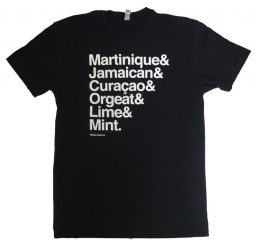 Of course, the Mai Tai recipe that Berry published wasn’t anything new (unlike the Zombie, where Berry literally pieced the recipe together via coded recipes). After all, Bergeron published the recipe in his 1972 Bartender’s Guide and several subsequent books. However, by the 1990s Trader Vic’s was no longer producing the Mai Tai Rum called for in that book. So, Berry used the alternate rum blend listed and transcribed a recipe calling for Jamaican and Martinique rums. Due to the popularity of Berry’s books, bars of all kinds started providing a Mai Tai made to the 1944 recipe formulation, and with currently available Martinique Rhum Agricole and Jamaica rums as the base. This formula was later cleverly employed by Tiki Problems for a t-shirt design.
Of course, the Mai Tai recipe that Berry published wasn’t anything new (unlike the Zombie, where Berry literally pieced the recipe together via coded recipes). After all, Bergeron published the recipe in his 1972 Bartender’s Guide and several subsequent books. However, by the 1990s Trader Vic’s was no longer producing the Mai Tai Rum called for in that book. So, Berry used the alternate rum blend listed and transcribed a recipe calling for Jamaican and Martinique rums. Due to the popularity of Berry’s books, bars of all kinds started providing a Mai Tai made to the 1944 recipe formulation, and with currently available Martinique Rhum Agricole and Jamaica rums as the base. This formula was later cleverly employed by Tiki Problems for a t-shirt design.
A few years later, Martin Cate was looking into historical material as part of the research for his 2016 book Smuggler’s Cove: Exotic Cocktails, Rum, and the Cult of Tiki. Cate noticed that the descriptions in Bergeron’s essay on the history of the Mai Tai sure didn’t describe the Martinique rums he was familiar with. After some sleuthing of his own, he concluded that the Martinique rum used by Vic’s in the 1950s wasn’t a Rhum Agricole made from sugar cane juice, but a Rhum Industiel made from molasses. This led Cate to consult with Denizen Rum to produce Denizen Merchant’s Reserve, a product containing aged Jamaican rum along with molasses-based rum from Martinique. Due to Cate’s stature and the popularity of the book, Denizen became the de facto single-bottle rum for a Mai Tai in many bars across the world.
The Mai Tai was born with aged Jamaican rum, but the wider availability of cane juice-based rums from Mexico, Martinique, and Hawaii has means there’s been an explosion of flavor options for bars to offer in their Mai Tais. Combined with the increased premiumization of rum as a spirits category, the craft cocktail revolution has uplifted the Mai Tai to a cornerstone of any quality bar program. While the original Mai Tai had aged Jamaican rum, over the years Trader Vic’s has used molasses and cane juice-based rums from Martinique, and rums from Puerto Rico, the Virgin Islands, and Jamaica in the designated rum blends for a Mai Tai. The specs have shifted over the generations and may shift in the future.
Mai Tai Day
Tiki bars rode the wave of nostalgia culture in the 1990s and had something of a comeback. For the first time in decades, new tiki bars were opening. And a new generation of proprietors began to blend the past with the present. One such neo pioneer was Michael Thanos, an Oakland pizza restaurant owner who got bit by the tiki bug the first time he sipped a Mai Tai at the Emeryville Trader Vic’s. Soon Thanos was converting the upstairs of the restaurant and turning it into a tiki bar. The Conga Lounge was the first new tiki bar to open in Oakland in decades and Thanos shortly thereafter launched a more fully realized establishment when Forbidden Island Tiki Lounge opened in nearby Alameda in 2006.
Every once in a while you come into contact with a true believer and Thanos is one of these true believers. He teamed with his brother and business partner Mano Thanos along with publicist Will “The Thrill” Viharo to petition the city of Oakland to name the Mai Tai the official cocktail of the city. Though that effort was ultimately unsuccessful, Councilwoman Rebecca Kaplan did push to declare August 30, 2009 to be Mai Tai Day in Oakland. August 30 is now the date that Mai Tai fans and tikiphiles choose to make their pilgrimage to Trader Vic’s or their favorite tiki bar to raise a Mai Tai in honor of The Trader.
In 2019, the Mai Tai celebrated its 75th anniversary. On a sunny Saturday in late August, Trader Vic’s Emeryville held a special event to celebrate the occasion. Every single square foot of public space was used at the restaurant, including all of the dining rooms, the outdoor patio, and the venerable Mai Tai Lounge. Bands and DJs played, arts and craft vendors crammed into corners selling their wares, photo booths allowed guests to capture the moment, and a buffet provided an all-you-can-eat opportunity for hundreds of guests to sample some of the best food that Trader Vic’s offers. And of course there were Mai Tais. As the party reached its apex of capacity, Trader Vic’s granddaughter Eve Bergeron called the revelers together for a toast. And then she passed the microphone over to Michael Thanos, who like a country preacher brought the assembled crowd to a fevered crescendo by proclaiming “Long live Trader Vic’s! Long live the Mai Tai!“

Mai Tai Lingo
80 years after its creation, Bergeron’s original recipe is still the best version of the Mai Tai. But as recently as the early 2000s it was very difficult to agree on the right lingo when ordering a Mai Tai made to the original recipe’s specifications. Do you call it the “original Mai Tai” or the “Trader Vic’s Mai Tai” or what?
Bergeron’s grandson and then Trader Vic’s CEO Peter Seely told me in 1998 to ask for the “Old Way Mai Tai” when I wanted one made from scratch and not with the Mai Tai concentrate mix that was almost exclusively used in the Trader Vic’s restaurants in those days. This Old Way Mai Tai term was used in Trader Vic’s press materials in that same time period, yet not even ten years later the Old Way Mai Tai was something different. Martin Cate tells the story in Smuggler’s Cove that he was bartending at the Trader Vic’s in San Francisco and was told the “Old Way Mai Tai” was just a regularly prepared Mai Tai with an extra float of 151 proof Rum. Due to trademark reasons Trader Vic’s uses the term “Original Mai Tai” to refer to a scratch Mai Tai these days.
Thankfully, in the last decade many quality cocktail and tiki bars have adopted the moniker “1944 Mai Tai” as the easy way to refer to a cocktail made according to ratios of the original recipe. Of course, bartenders aren’t used using the Wray & Nephew 17 rum that hasn’t been issued in decades, instead they use high quality rum or a blend (typically aged, often Jamaican), quality orgeat, and freshly mixed ingredients. .
Generic 1944 Mai Tai Recipe
1 oz Lime juice
½ oz Orgeat
¼ oz Rock Candy Syrup or Demerara Syrup
½ oz Orange Curacao
2 oz Aged Rum
Shake with crushed ice and garnish with the spent lime shell and a mint sprig.
No pineapple juice or orange juice or grenadine or coconut rum or falernum or…, well, you get the picture. Just a Mai Tai made with lime juice, orgeat, curacao, maybe some sugar, and of course your favorite quality rum with plenty of age.
Just like the Trader made it in 1944. Mai Tai – Roa Ae.
